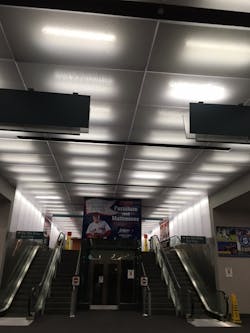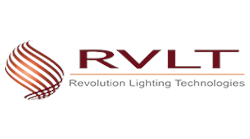Create an Enlightend Experience for Travelers with LED Lighting Technologies
Time spent at the airport can make or break a passenger’s travel experience, which is why airport facility managers across the nation are aiming to create a more comfortable environment for its customers through enhanced lighting technologies. Recent studies have shown the potential impact of light on individual health, well-being and comfort, all of which are critical to the airport experience. Simultaneously, deployment of certain lighting technologies like LEDs have displayed proven benefits of efficiency and cost savings across various areas of airport facilities, while providing brighter, safer lighting conditions.
From the terminal to the tarmac, recent advancements in LED lighting technologies are enabling airport facility managers to improve efficiency, cost, safety, and the overall experience for travelers.
Enhancing efficiency with longer lifespans and targeted lighting
In order to reap the extensive benefits associated with LED lighting, facility managers are capitalizing on the diversity of applications that LED lighting can address to generate comprehensive efficiency and greater light quality throughout the facility. This is particularly important in airports where numerous lighting styles are needed and used for various sections of the airport, ranging from interior areas, such as terminals, to exterior spaces, including the tarmac, terminal entrances and parking lots.
Throughout many older airports, the metal-halide and fluorescent based fixture have been the staples of airport lighting design, deployed throughout many facility spaces. While this solution had been sufficient to meet aviation facility’s needs over the past 20-30 years, it has become clear that the maturity of LED lighting is rendering them obsolete. Aside from its versatility, offered in many styles, shapes and forms, LED superiority reigns through efficiency, which is approximately 40 to 60 percent more efficient than florescent and metal halide lighting technologies alone. This signals a clear opportunity for facility managers who are looking to significantly reduce operating expenses, providing cost savings to drive greater profitability or that can be applied toward other operational needs within airports. TF Green, an international airport located in Warwick, Rhode Island, is one successful example, that recently completed an LED lighting and controls retrofit throughout its interior and exterior facilities, and replaced outdated lighting technologies to drive greater efficiency. As a result of this lighting retrofit program the airport was able to significantly lower operating expenses by reducing lighting energy use by 60 percent and achieve a return on investment of only 2.2 years.
Longer lifespan is another key benefit of LED lighting, offering airport facility managers a means to reduce long term maintenance costs. LED’s today can achieve up to 100,000 hours of lamp life, more than three times longer than other lighting technologies. TF Green addressed the existing metal-halide lamps, which offer a comparatively shorter lamp life of only 20,000 hours, throughout the exterior of the facility, including the tarmac. This lighting upgrade will now significantly reduce the amount of time spent by facility staff for general monitoring and response to maintenance calls to replace burned out lighting. In addition, future material cost purchases are lowered dramatically through the elimination of expensive metal halide lamp, and fluorescent lighting ballast purchases.
While the longer life of LED’s provides clear cost savings, the technology has also been found to positively affect long term light quality, referred to as lumen maintenance. Most metal-halide lamps only offer 60 percent lumen maintenance, resulting in a 30 percent loss of light output that occurs after only 5,000 hours of use. As a result, facilities receive a lower quality light for three quarters of a metal halide fixtures lifespan, which can limit visibility in critical areas of the airport campus, negatively impacting experience within the facility. While LED’s also lose lighting output over time, they offer a much higher lumen maintenance of approximately 92 at 50,000 hours. This means that only 8 percent of the lighting output lost throughout half the LED’s lifespan giving facility managers better quality light that lasts longer and continues to reduce overall operation and maintenance costs.
Light pollution is also another key consideration among airports today, responding to calls from environmental action groups focused on reducing the negative impact of light emitted beyond the boundary of airports and other large facilities at night. To address these concerns, LED providers are creating “Dark sky technology,” which minimizes lighting pollution, unlike preceding lighting technologies, integrating optic feature to ensure directional lighting, enabling targeted light directed at a specific object’s surface such as a tarmac or a parking garage.
Creating a comfortable environment for travelers
Creating a comfortable and healthy setting for both customers and staff is extremely important among airport facilities today. A study on behavioral neuroscience from Munch, Borisuit, and Scartezzini revealed that subjects who were exposed to natural light were significantly more alert when tested in the early evening as opposed to their counterparts who were exposed to artificial lighting. Simultaneously, cognitive function of those exposed to natural light was significantly greater with lower sleepiness in the evening and correlating cognitive performance showing that even short-term lighting conditions during the afternoon had a positive impact on cognitive task performance in the evening . In a place where pilots and staff need to be alert for safety reasons, and passengers traveling need to be aware of time schedules or attentive for work purposes, deploying lighting technology that keeps individuals alert and awake is critical.
To create that friendly, safe environment for traveling passengers, lighting throughout an airport facility should strive to emulate natural light conditions as best as possible. While the integration of natural light has become more common in current airport design, artificial lighting that produces “full spectrum” light, should be considered. At TF Green, this was a big consideration as it would be important not only for travelers within the airport but also for staff who needed to be alert, and have a clear line of vision to perform their jobs in a safe manner. LEDs can provide an optimal solution as they offer the capability to maximize spectral adjustment through its diodes, to closely match that of natural light. Even at different color temperatures, LEDs are able to achieve a broad spectral output, and be modified to ensure strong “blue peaks” of light frequency, which medical studies have shown to provide the greatest positive effect on our key body functions.
Creating better lighting quality in temperature and color
Quality of light is another factor for airport facility maintenance managers today, and must be evaluated along with the energy usage of the light source to balance the proper levels of efficiency and quality of light. Efficacy, a measurement of the amount of light output versus wattage versus energy used, should always be considered with proper lighting design. For airport maintenance and operations mangers looking for the highest quality, solutions with higher efficacy values will ensure both the greatest efficiency and light output. When compared to the performance standard of lumens-per-watt (lm/W), most LEDs (120-140 lm/W) are five to seven times more efficient than incandescent bulbs, and up to twice as efficient as compact fluorescents. This is why LED’s are continually selected for renovation and retrofit projects, like the one at TF Green, particularly with interior light fixtures.
In addition to the amount of light output, accurate color rendering should be considered. LED’s offer a greater color rendering index (CRI) for example, achieving values of approximately 85 or higher (measured on a 0 to 100 scale), compared with fluorescent lighting that typically produces CRI values of 75 or lower. As a result, aesthetics across the airport can be further enhanced for travelers.
In conjunction with CRI, correlated color temperature (CCT), measurement of the light’s color appearance, must also be considered when enhancing an airport’s aesthetics. Measured in kelvin (K), studies have shown that LED’s ranging from 6,000K-8,000K display the most beneficial biological impact, however the resulting light color is highly undesirable. On the other end of the spectrum, studies found that LED’s ranging from, 3,500K (neutral) to 5,500K (cool) were found to be the most visually pleasing for individuals.
Incorporating automation for better control
For some airports, incorporation of advanced automation and controls has been found to enhance efficiency, resulting in further cost savings. Smart control systems, including internet based programs, enables easy monitoring and quick response to all needs throughout the entirety of the airport from a single screen. Facility maintenance managers can evaluate the wattage of each fixture, identify maintenance functions needed, and control lighting output throughout all areas of the airport campus, including the parking garages, interior locations, and exterior of the facility through the use of smart fixture technology, which connects all lighting systems to a single computer software. Particularly for the interior of airports, smart technologies enable controls such as daylight harvesting and dimming which can provide 10-20 percent additional energy savings on top of the LED light fixture savings. Having complete control and supervision over all areas of the airport where lighting is used provides greater efficiency not just of energy use but also of staff allocation. Airports can reallocate staff, previously needed for lighting monitoring and maintenance efforts for other, more important tasks.
TF Green incorporated automation and controls in the form of smart LED fixtures which feature integrated comprehensive automation, allowing the fixture to turn on or off based on motion is the area. In addition, these smart fixtures utilize daylight harvesting, calculating the amount of light needed based on how much natural light is in the facility. This technology, optimizing energy and maintenance performance, provided a cost effective solutions for TF Green Airport to maximize savings with a quicker return on investment.
TF Green on going green for sustainability initiatives
Beyond the impact on individuals, LED lighting has helped airports enhance their sustainable initiatives. Reducing its carbon footprint through reduced energy consumption, TF Green received the Northeast Energy Efficiency Partnership award (NEEP). In addition, the projects use of LED lighting eliminates the use of mercury and other heavy metals from its lighting sources, while providing a solution that is 100 percent recyclable.
Lighting technologies can have a significant impact for airports today, including customers and staff alike. Incorporating the right technology is not only valuable to the traveler’s experience, but can also provide benefits for safety and health in addition to energy and cost savings. The adoption of LED lighting, combined with advanced control technologies, are redefining the potential for airport design, offering a greater experience for all.
Ron Sliney, a graduate in Electrical Engineering from Northeastern University, began his career in 1987 in the GE Technical Management Program. From there he became an Account Executive for GE Lighting servicing the New England and NY areas. In 1996, Ron joined Energy USA (an energy service company) as Director of National Sales where he was responsible for establishing a New England sales team and growing national accounts. In 2003, he joined his business partner Michael Lemoi in forming Energy Source in Providence, RI. Over the last 14 years Energy Source has provided turn-Key energy services for its customers. Energy Source services include energy audits, equipment upgrade recommendations, energy savings calculation, utility incentive administration and full turn-key installation proposals.







